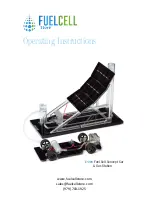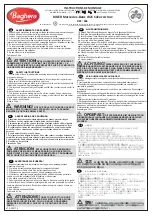
K021 Instructions v1.0
Race Prep
Page
72
RACE PREPARATION
The 5 Ps:
Proper Preparation Prevents Poor Performance
. You want a well-built car
when you arrive at the track, but top drivers also have a routine before
every
run to
make sure the car’s settings are consistent each time out. This makes sure the car on
the track is indeed what you wanted, and any performance difference is the result of
deliberate changes. Here is a list of things we check each time the car hits the track, for
practice or racing. It’s meant to be a quick reference list; for a more comprehensive
discussion of each setting check the Tuning Section. After a few times, the list should
be routine and only take a few moments; you’ll be rewarded with a car that’s consistent,
more responsive, and faster overall. Start with a car ready to run, body off.
1 – Check ride height. Find a flat and level surface; if you’re going to use a gauge make
sure the surface is hard, as a pit towel could throw off your readings. Check the front
height, then the rear, and from the side take a look at the ‘rake’ of the car. Even little
changes – anti-squat adjustment, shock mounting holes, different tires, etc – will change
the ride height, so it’s very important to check this every time the car hits the track.
2 – Look over your X – 6 Squared. This is easily done as you adjust ride height above.
Just keep your eyes open as you go through the list. Feel the shocks, inspect the
ballstuds, etc. You’d be amazed how many times we find a ballstud or shock nut
working loose, or a loose/cracked part before a qualifier or race.
3 – Check camber front and rear. The one thing that can throw off camber
measurements more than anything else is bent rims. If the top of your wheel wobbles in
and out as you rotate the tire your rim is probably bent slightly. This isn’t the end of the
world; you don’t have to replace the tire. Simply identify a spot between the extremes,
rotate the tire so that point is on the top, and set your camber from there.
4 – Check the front Toe-in. Center the steering rack under the top plate, then look at
the front wheels. If you don’t have a toe-in gauge, stand up and look down at the front
of the car for a better perspective.
5 – Set your slipper clutch and diff. We generally recommend the 'hold the rear tires
and punch it’ method: Turn the car and transmitter on, hold the rear wheels securely,
and give the transmitter a quick burst of 100% throttle – don’t be shy! You should hear a
high-pitched whine as the front end lifts off your pit table; that's the slipper working. If
the diff slips (a screech sound) stop immediately and tighten it a 1/4 turn or so. Back off
the slipper and try again. Besides listening, watch the front end of your X – 6 Squared
as you do this. The higher off the table your front tires get the tighter is your slipper.















































